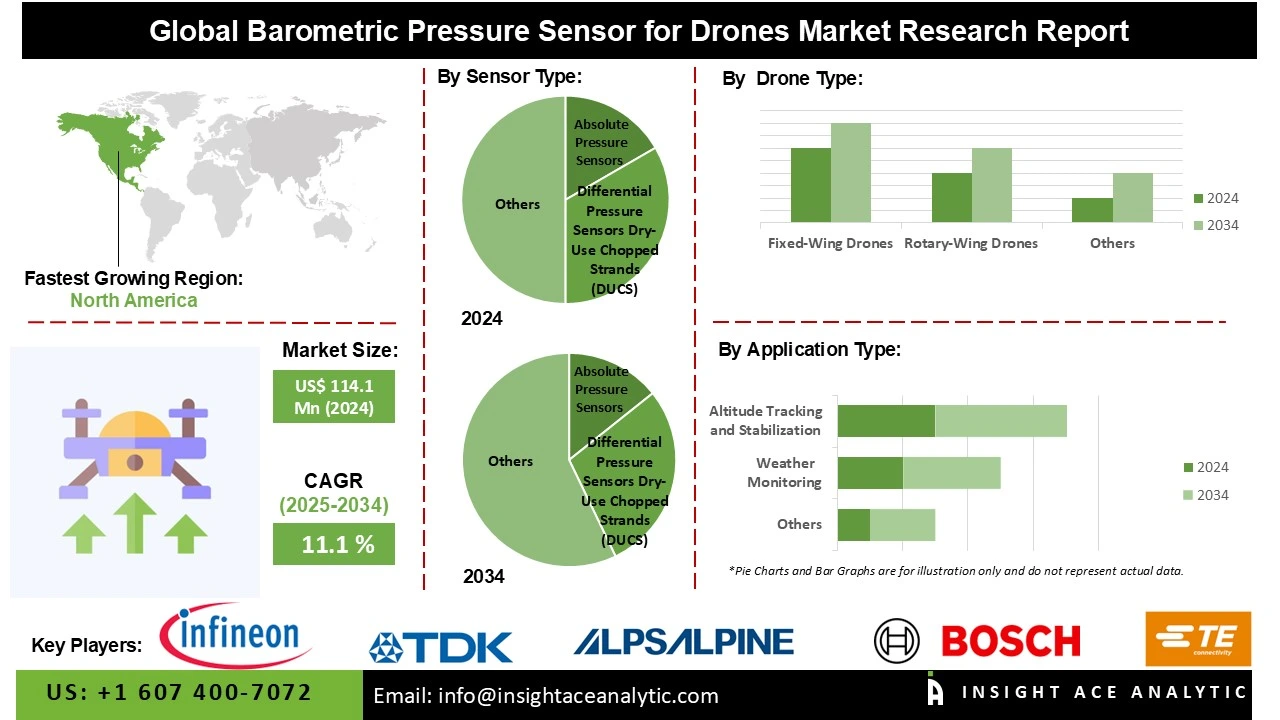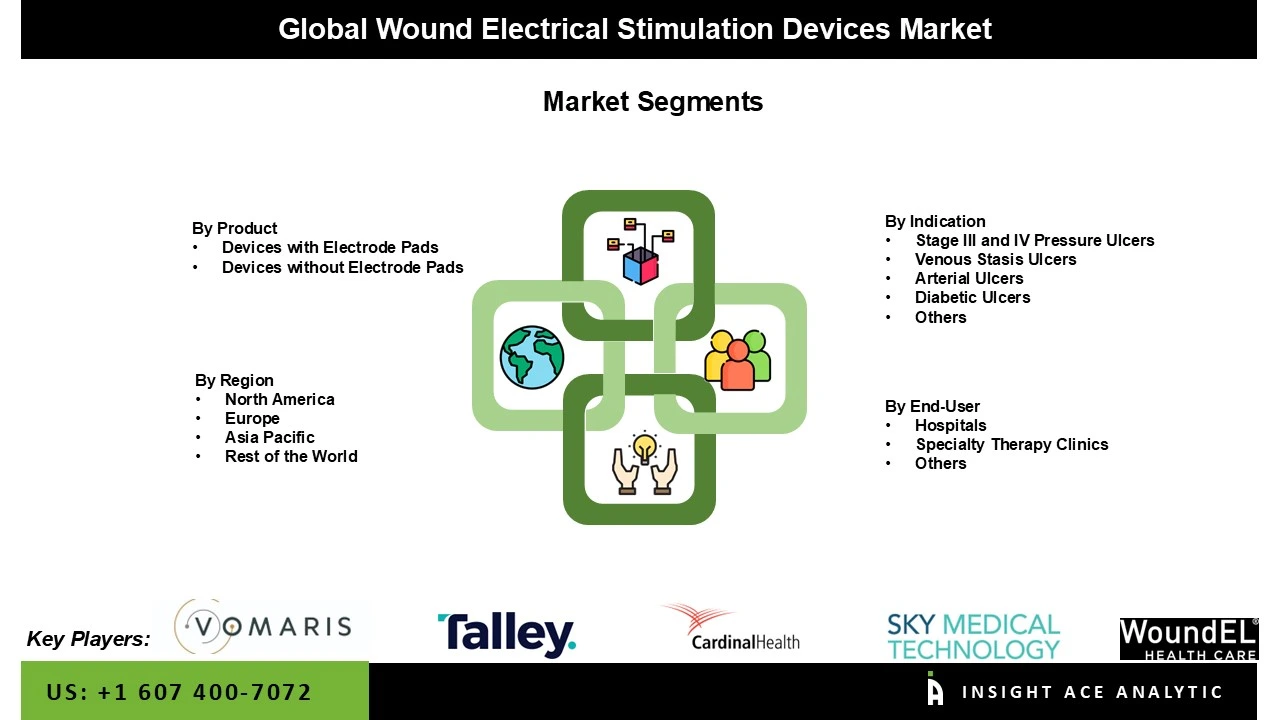Global Wound Electrical Stimulation Devices Market Size is valued at US$ 209.9 Mn in 2024 and is predicted to reach US$ 443.8 Mn by the year 2034 at an 8.0% CAGR during the forecast period for 2025-2034.
Wearable sweat sensors are non-invasive patches or bands that analyze sweat in real-time to monitor health biomarkers like electrolytes, glucose, and hormones. They provide immediate insights into hydration, athletic performance, and medical conditions by wirelessly transmitting data to a smartphone.

The wound electrical stimulation devices market is experiencing significant growth, firstly driven by the increasing demand for non-invasive therapies. Patients and physicians are both resorting to pain-free therapies that reduce the risk of infection, promote faster recovery without surgery, and heal tissues faster. Electrical stimulation heals tissues faster, promotes circulation, reduces inflammation and is therefore the first choice for chronic wounds, burns, and ulcers. The rise in diabetic wounds and pressure ulcers also drives adoption. The demand for cost-effective, home-care solutions and the evolution of portable device technology also accelerate the rate at which the market expands globally.
The wound electrical stimulation devices market is expanding due to technological innovation in electrical stimulation improves the efficacy of treatments and patient outcomes. Modern devices are able to provide more accurate, adjustable currents, enhancing rates of wound healing for chronic ulcers, pressure sores, and post-operative wounds.
Compatibility with intelligent monitoring systems enables real-time feedback and improved treatment optimization. Miniaturization and portability increase ease of use in home healthcare, supporting compliance. In addition, advancements in electrode technology and wireless communication minimize discomfort and enhance user-friendliness, rendering electrical stimulation a more predictable, non-surgical alternative to traditional wound care therapy.
Some of the Key Players in the Wound Electrical Stimulation Devices Market:
The wound electrical stimulation devices market is categorized through multiple segmentation criteria. These include product type (distinguished as devices with electrode pads and those without), clinical indication (covering stage III and IV pressure ulcers, venous stasis ulcers, arterial ulcers, and diabetic ulcers, among others), and end-user (primarily hospitals and specialty therapy clinics). Additionally, the market is analyzed geographically through regional segmentation.
In 2024, the devices with electrode pads segment held the major market share in the wound electrical stimulation devices market. This is due to the growing incidence of chronic wounds like pressure ulcers, diabetic foot ulcers, and venous leg ulcers. Electrode pad-based devices provide accurate electrical stimulation, increasing blood flow, stimulating cell migration, and speeding up wound healing. Increasing geriatric population, rising incidence of diabetes, and need for cost-effective, non-invasive therapies for wound management are major drivers. Portable, easy-to-use electrode pad device technology innovations further accelerate adoption in home care and clinical settings.
The wound electrical stimulation devices market is dominated by hospitals due to the rising demand for advanced wound care solutions. Hospitals are increasingly adopting these devices to treat chronic wounds such as pressure ulcers, diabetic foot ulcers, and venous leg ulcers, which are prevalent among ageing and diabetic populations. Electrical stimulation accelerates healing, reduces infection risks, and shortens hospital stays, making it a cost-effective option. Growing clinical evidence supporting efficacy and hospital investments in modern wound management technologies further drives adoption.
North America dominates the market for wound electrical stimulation devices due to the region’s rising prevalence of chronic wounds. The region’s high burden of diabetes and obesity increases demand for advanced wound care solutions. Growing awareness of faster healing benefits, supportive reimbursement policies, and technological advancements in electrotherapy devices further boost adoption. Additionally, the existence of strong healthcare infrastructure and increasing investments in innovative wound care technologies fuel market expansion.
In addition, Europe is the second-largest region in the market for wound electrical stimulation devices. This is attributed to actively increasing prevalence of chronic wounds, like pressure ulcers, diabetic foot ulcers, and venous leg ulcers, due to an aging population and rising diabetes cases. The growing need for cutting-edge, non-invasive therapies that accelerate wound healing and reduce infection risk supports adoption. Moreover, supportive reimbursement policies, strong clinical research, and rising investments in healthcare innovation encourage the use of electrical stimulation devices across hospitals and homecare settings.
| Report Attribute | Specifications |
| Market Size Value In 2024 | USD 209.9 Mn |
| Revenue Forecast In 2034 | USD 443.8 Mn |
| Growth Rate CAGR | CAGR of 8.0% from 2025 to 2034 |
| Quantitative Units | Representation of revenue in US$ Mn and CAGR from 2025 to 2034 |
| Historic Year | 2021 to 2024 |
| Forecast Year | 2025-2034 |
| Report Coverage | The forecast of revenue, the position of the company, the competitive market structure, growth prospects, and trends |
| Segments Covered | By Product, By Indication, By End-User and By Region |
| Regional Scope | North America; Europe; Asia Pacific; Latin America; Middle East & Africa |
| Country Scope | U.S.; Canada; Germany; The UK; France; Italy; Spain; Rest of Europe; China; Japan; India; South Korea; Southeast Asia; Rest of Asia Pacific; Brazil; Argentina; Mexico; Rest of Latin America; GCC Countries; South Africa; Rest of the Middle East and Africa |
| Competitive Landscape | Accel-Heal Technologies Limited, Vomaris Innovations, Inc., WoundEL Health Care, Diapulse Corporation, Sky Medical Technology Ltd., Cardinal Health, Inc., Talley Group Limited, Convatec Limited, DeRoyal Industries, Inc., Devon Medical, Inc. |
| Customization Scope | Free customization report with the procurement of the report, Modifications to the regional and segment scope. Geographic competitive landscape. |
| Pricing and Available Payment Methods | Explore pricing alternatives that are customized to your particular study requirements. |
Wound Electrical Stimulation Devices Market by Product-
· Devices with Electrode Pads
· Devices without Electrode Pads

Wound Electrical Stimulation Devices Market by Indication -
· Stage III and IV Pressure Ulcers
· Venous Stasis Ulcers
· Arterial Ulcers
· Diabetic Ulcers
· Others
Wound Electrical Stimulation Devices Market by End-User-
· Hospitals
· Specialty Therapy Clinics
· Others
Wound Electrical Stimulation Devices Market by Region-
North America-
· The US
· Canada
Europe-
· Germany
· The UK
· France
· Italy
· Spain
· Rest of Europe
Asia-Pacific-
· China
· Japan
· India
· South Korea
· Southeast Asia
· Rest of Asia Pacific
Latin America-
· Brazil
· Argentina
· Mexico
· Rest of Latin America
Middle East & Africa-
· GCC Countries
· South Africa
· Rest of the Middle East and Africa
Chapter 1. Methodology and Scope
1.1. Research Methodology
1.2. Research Scope & Assumptions
Chapter 2. Executive Summary
Chapter 3. Global Wound Electrical Stimulation Devices Market Snapshot
Chapter 4. Global Wound Electrical Stimulation Devices Market Variables, Trends & Scope
4.1. Market Segmentation & Scope
4.2. Drivers
4.3. Challenges
4.4. Trends
4.5. Investment and Funding Analysis
4.6. Porter's Five Forces Analysis
4.7. Incremental Opportunity Analysis (US$ MN), 2025-2034
4.8. Competitive Landscape & Market Share Analysis, By Key Player (2024)
4.9. Use/impact of AI on Wound Electrical Stimulation Devices Market Industry Trends
4.10. Global Wound Electrical Stimulation Devices Market Penetration & Growth Prospect Mapping (US$ Mn), 2024-2034
Chapter 5. Wound Electrical Stimulation Devices Market Segmentation 1: By Product, Estimates & Trend Analysis
5.1. Market Share by Product, 2024 & 2034
5.2. Market Size Revenue (US$ Million) & Forecasts and Trend Analyses, 2021 to 2034 for the following Product:
5.2.1. Devices with Electrode Pads
5.2.2. Devices without Electrode Pads
Chapter 6. Wound Electrical Stimulation Devices Market Segmentation 2: By Indication, Estimates & Trend Analysis
6.1. Market Share by Indication, 2024 & 2034
6.2. Market Size Revenue (US$ Million) & Forecasts and Trend Analyses, 2021 to 2034 for the following Indication:
6.2.1. Stage III and IV Pressure Ulcers
6.2.2. Venous Stasis Ulcers
6.2.3. Arterial Ulcers
6.2.4. Diabetic Ulcers
6.2.5. Others
Chapter 7. Wound Electrical Stimulation Devices Market Segmentation 3: By End-User, Estimates & Trend Analysis
7.1. Market Share by End-User, 2024 & 2034
7.2. Market Size Revenue (US$ Million) & Forecasts and Trend Analyses, 2021 to 2034 for the following End-User:
7.2.1. Hospitals
7.2.2. Specialty Therapy Clinics
7.2.3. Others
Chapter 8. Wound Electrical Stimulation Devices Market Segmentation 4: Regional Estimates & Trend Analysis
8.1. Global Wound Electrical Stimulation Devices Market, Regional Snapshot 2024 & 2034
8.2. North America
8.2.1. North America Wound Electrical Stimulation Devices Market Revenue (US$ Million) Estimates and Forecasts by Country, 2021-2034
8.2.1.1. US
8.2.1.2. Canada
8.2.2. North America Wound Electrical Stimulation Devices Market Revenue (US$ Million) Estimates and Forecasts by Product, 2021-2034
8.2.3. North America High-Altitude Oxygen Simulation Market Revenue (US$ Million) Estimates and Forecasts by Indication, 2021-2034
8.2.4. North America Wound Electrical Stimulation Devices Market Revenue (US$ Million) Estimates and Forecasts by End-User, 2021-2034
8.3. Europe
8.3.1. Europe Wound Electrical Stimulation Devices Market Revenue (US$ Million) Estimates and Forecasts by Country, 2021-2034
8.3.1.1. Germany
8.3.1.2. U.K.
8.3.1.3. France
8.3.1.4. Italy
8.3.1.5. Spain
8.3.1.6. Rest of Europe
8.3.2. Europe Wound Electrical Stimulation Devices Market Revenue (US$ Million) Estimates and Forecasts by Product, 2021-2034
8.3.3. Europe Wound Electrical Stimulation Devices Market Revenue (US$ Million) Estimates and Forecasts by Indication, 2021-2034
8.3.4. Europe Wound Electrical Stimulation Devices Market Revenue (US$ Million) Estimates and Forecasts by End-User, 2021-2034
8.4. Asia Pacific
8.4.1. Asia Pacific Wound Electrical Stimulation Devices Market Revenue (US$ Million) Estimates and Forecasts by Country, 2021-2034
8.4.1.1. India
8.4.1.2. China
8.4.1.3. Japan
8.4.1.4. Australia
8.4.1.5. South Korea
8.4.1.6. Hong Kong
8.4.1.7. Southeast Asia
8.4.1.8. Rest of Asia Pacific
8.4.2. Asia Pacific Wound Electrical Stimulation Devices Market Revenue (US$ Million) Estimates and Forecasts by Product, 2021-2034
8.4.3. Asia Pacific Wound Electrical Stimulation Devices Market Revenue (US$ Million) Estimates and Forecasts by Indication, 2021-2034
8.4.4. Asia Pacific Wound Electrical Stimulation Devices Market Revenue (US$ Million) Estimates and Forecasts by End-User, 2021-2034
8.5. Latin America
8.5.1. Latin America Wound Electrical Stimulation Devices Market Revenue (US$ Million) Estimates and Forecasts by Country, 2021-2034
8.5.1.1. Brazil
8.5.1.2. Mexico
8.5.1.3. Rest of Latin America
8.5.2. Latin America Wound Electrical Stimulation Devices Market Revenue (US$ Million) Estimates and Forecasts by Product, 2021-2034
8.5.3. Latin America Wound Electrical Stimulation Devices Market Revenue (US$ Million) Estimates and Forecasts by Indication, 2021-2034
8.5.4. Latin America Wound Electrical Stimulation Devices Market Revenue (US$ Million) Estimates and Forecasts by End-User, 2021-2034
8.6. Middle East & Africa
8.6.1. Middle East & Africa Wind Turbine Rotor Blade Market Revenue (US$ Million) Estimates and Forecasts by country, 2021-2034
8.6.1.1. GCC Countries
8.6.1.2. Israel
8.6.1.3. South Africa
8.6.1.4. Rest of Middle East and Africa
8.6.2. Middle East & Africa Wound Electrical Stimulation Devices Market Revenue (US$ Million) Estimates and Forecasts by Product, 2021-2034
8.6.3. Middle East & Africa Wound Electrical Stimulation Devices Market Revenue (US$ Million) Estimates and Forecasts by Indication, 2021-2034
8.6.4. Middle East & Africa Wound Electrical Stimulation Devices Market Revenue (US$ Million) Estimates and Forecasts by End-User, 2021-2034
Chapter 9. Competitive Landscape
9.1. Major Mergers and Acquisitions/Strategic Alliances
9.2. Company Profiles
9.2.1. Accel-Heal Technologies Limited
9.2.1.1. Business Overview
9.2.1.2. Key Product /Service Overview
9.2.1.3. Financial PerEnd-Userance
9.2.1.4. Geographical Presence
9.2.1.5. Recent Developments with Business Strategy
9.2.2. Vomaris Innovations, Inc.
9.2.3. WoundEL Health Care
9.2.4. Diapulse Corporation
9.2.5. Sky Medical Technology Ltd.
9.2.6. Cardinal Health, Inc.
9.2.7. alley Group Limited
9.2.8. Convatec Limited
9.2.9. DeRoyal Industries, Inc.
9.2.10. Devon Medical, Inc.